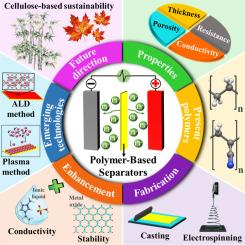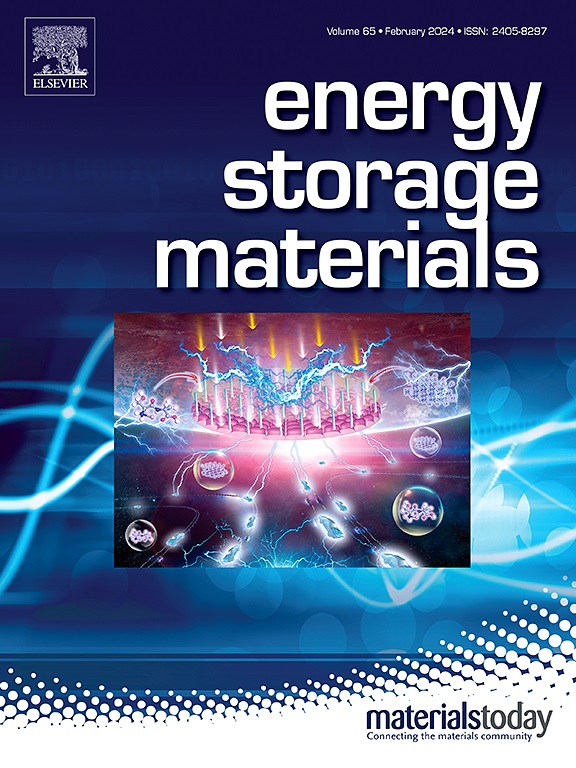Advancements and challenges in polymer-based separators for lithium-ion batteries
IF 20.2
1区 材料科学
Q1 CHEMISTRY, PHYSICAL
引用次数: 0
Abstract
Recently, polymer-based separators have brought significant advances in energy storage devices. This review provides a comprehensive overview of the substantial developments and persistent challenges of membrane separators used in lithium-ion battery (LIB) systems, focusing on the role and innovation surrounding polymer-based membrane separators. The article highlights the critical role of membrane separators in improving battery performance, safety, and lifetime. The article emphasizes the importance of the work of readers in this field, as their contributions are also essential and indispensable in shaping the future of battery technologies. The article introduces the latest advances in ultra-high molecular polyethylene (UHMWPE), polypropylene (PP), polyvinylidene fluoride (PVDF), polyurethane (PU), polyimide (PI) … and new polymer composite materials such as carbon nanotubes (CNTs) and polysulfone (PSF), graphene oxide (GO) with polybenzimidazole (PBI), polystyrene (PS), etc… ensuring that readers are well-informed about the latest trends in energy storage. The review also evaluates various strategies for enhancing the chemical and thermal stability, ionic conductivity, and mechanical properties of membranes. In addition, it also highlights future directions to overcome limitations, such as dendrite growth and thermal instability, which have significant potential for the energy storage field. It highlights the potential of new polymer materials, inspiring hope and optimism about the exciting possibilities in separation technology research and development. These advances are pivotal in meeting the growing demand for efficient, safe, and environmentally friendly energy storage solutions, thereby opening up new horizons in the field of battery technology.


锂离子电池聚合物基隔膜的研究进展与挑战
最近,基于聚合物的隔膜为储能设备带来了重大进展。本综述全面概述了锂离子电池(LIB)系统中使用的膜分离器的实质性发展和持续挑战,重点关注聚合物基膜分离器的作用和创新。文章强调了隔膜在提高电池性能、安全性和使用寿命方面的关键作用。文章强调了该领域读者工作的重要性,因为他们的贡献对于塑造电池技术的未来也是不可或缺的。文章介绍了超高分子量聚乙烯(UHMWPE)、聚丙烯(PP)、聚偏二氟乙烯(PVDF)、聚氨酯(PU)、聚酰亚胺(PI)......以及新型聚合物复合材料(如碳纤维)的最新进展。以及新型聚合物复合材料,如碳纳米管 (CNT) 和聚砜 (PSF)、氧化石墨烯 (GO) 和聚苯并咪唑 (PBI)、聚苯乙烯 (PS) 等......确保读者充分了解储能领域的最新趋势。综述还评估了增强膜的化学和热稳定性、离子传导性和机械性能的各种策略。此外,它还强调了克服枝晶生长和热不稳定性等限制因素的未来方向,这些限制因素在储能领域具有巨大潜力。它强调了新型聚合物材料的潜力,激发了人们对分离技术研发领域令人兴奋的可能性的希望和乐观态度。这些进展对于满足日益增长的对高效、安全和环保型能源存储解决方案的需求至关重要,从而为电池技术领域开辟了新的前景。
本文章由计算机程序翻译,如有差异,请以英文原文为准。
求助全文
约1分钟内获得全文
求助全文
来源期刊

Energy Storage Materials
Materials Science-General Materials Science
CiteScore
33.00
自引率
5.90%
发文量
652
审稿时长
27 days
期刊介绍:
Energy Storage Materials is a global interdisciplinary journal dedicated to sharing scientific and technological advancements in materials and devices for advanced energy storage and related energy conversion, such as in metal-O2 batteries. The journal features comprehensive research articles, including full papers and short communications, as well as authoritative feature articles and reviews by leading experts in the field.
Energy Storage Materials covers a wide range of topics, including the synthesis, fabrication, structure, properties, performance, and technological applications of energy storage materials. Additionally, the journal explores strategies, policies, and developments in the field of energy storage materials and devices for sustainable energy.
Published papers are selected based on their scientific and technological significance, their ability to provide valuable new knowledge, and their relevance to the international research community.
 求助内容:
求助内容: 应助结果提醒方式:
应助结果提醒方式:


